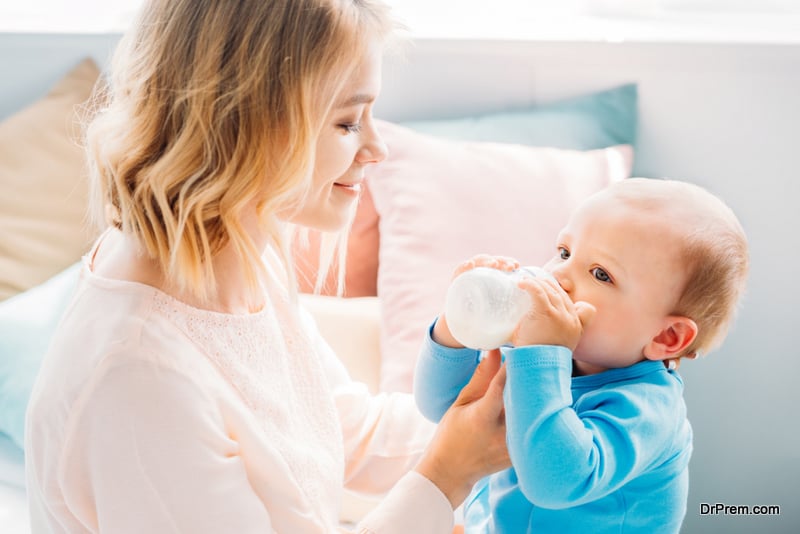Bottle feeding is a substitute to breastfeeding, partially or completely for some babies. Some mothers use the bottle for feeding breast milk, while others for outside milk and water. Many first time parents have a lot of doubts when they are getting ready for bottle feeding. Here are 10 bottle feeding tips to guide you.
1. Plastic or glass
One of the most common doubts while feeding your baby in a bottle is whether you should choose glass or plastic bottle. Plastic is lightweight and easy to handle. However, some plastics contain chemical bisphenol A. Hence check out the plastic bottles that are BPA-free.
2. Bottle nipples
The nipples used are mostly made of latex or silicon. The flow rates are also different according to the size of the hole. Try various nipples and see which is comfortable for your baby. Always check the nipple regularly and look for signs of discoloring and cracking. If you find them, it is time to replace it to avoid hazards like choking.
3. Sterilize the bottle
After buying the bottle, sterilize it in a pot of boiling water for about five minutes. Once you have sterilized it ,you can use hot water and detergent for washing it often. Washing by hand is better than using the dishwasher. According to certain studies, plastic bottles leach chemicals when exposed to high temperatures.
4. Separate bottles
Dedicate a bottle for feeding milk. Do not use this bottle for water or juices. Keep such bottles separately. Keeping a separate bottle for feeding milk can ensure hygiene.
5. What formula to choose
Parents mostly prefer to use formula made of cow’s milk. There are other types like hypoallergenic and soy formulas. For babies less than one year, use formulas fortified with iron. They are available in powder, concentrates and ready-to-use forms. When your baby is 6 months old, he should be consuming 6-8 ounces per feeding.
6. Warming
If your baby prefers to drink the formula with room temperature or cool temperature, then it is fine. But if you want to warm it never use the microwave. It will become too hot and burn your baby’s lips. All you have to do is dip the bottle is warm water for a few minutes or run it below a hot water tap. Test the temperature by putting a drop at the top of your hand to know the right temperature. Do not use the wrist because it is not as sensitive as the top part.
7. Holding your baby
Keep a clean cloth ready for wiping any spit milk. Use a bib on your baby. Cradle your baby in such a way that his head is in a higher position than his body. Hold the bottle and slowly introduce the nipple into his mouth through the sides. This can prevent choking, tooth decay, and gas formation. Burping your baby after every 2 ounces is also beneficial.
8. Signs for stopping bottle feed
To know if your baby’s done look at certain signals. He may turn away from the bottle, stop sucking, and even push the bottle away when he is a bit older. If you want to try once again go on, but do not force him.
9. Burping
Many babies burp after their bottle feed. The best way to burp your baby is by resting him on your shoulder. Hold your baby in this position and tap gently on his back. Some parents burp the babies by making them lay stomach-down in their lap and patting on the back. When you pat he may spit some milk. Use the clean cloth and wipe it off. Sometimes your baby may not burp. Wait for some time, if he is looking comfortable then there is nothing to worry.
10. Storing milk
Do not use the formula that is left in the bottle. If you have opened packages it is better to refrigerate them immediately. If you have the mixed formula left, use it within 48 hours. Always mix formulas only in small quantities according to your baby’s requirements. Breast milk can be stored for 24 hours in the refrigerator. If you freeze it, it can last for about four months. When you freeze it at zero degrees or colder it can last for 6-12 months.



